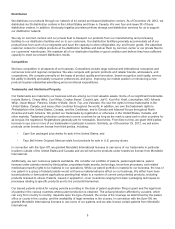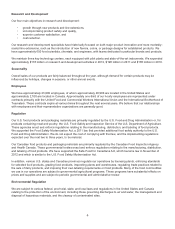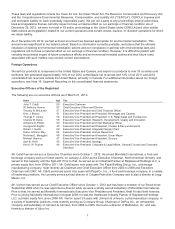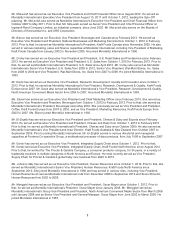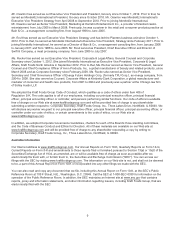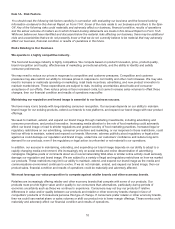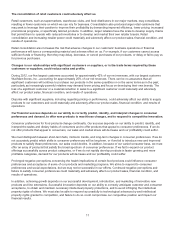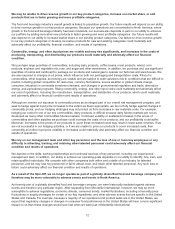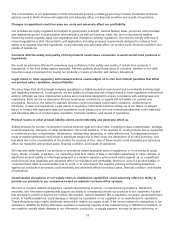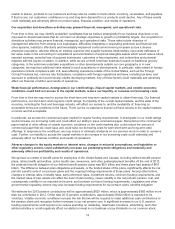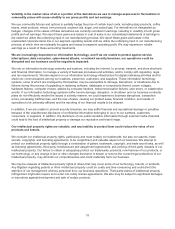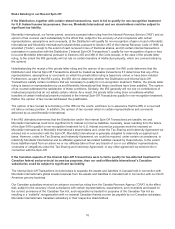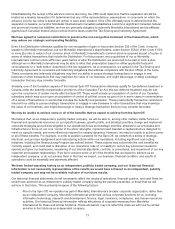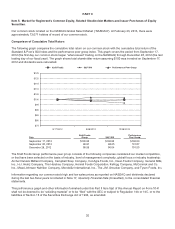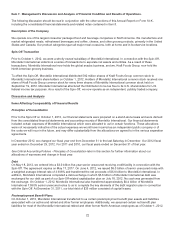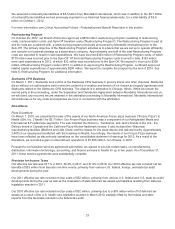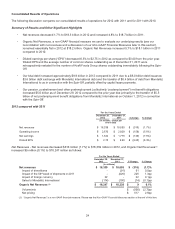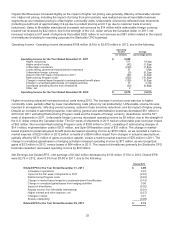Kraft 2012 Annual Report Download - page 17
Download and view the complete annual report
Please find page 17 of the 2012 Kraft annual report below. You can navigate through the pages in the report by either clicking on the pages listed below, or by using the keyword search tool below to find specific information within the annual report.Volatility in the market value of all or a portion of the derivatives we use to manage exposures to fluctuations in
commodity prices will cause volatility in our gross profits and net earnings.
We use commodity futures and options to partially hedge the price of certain input costs, including dairy products, coffee
beans, meat products, wheat, corn products, soybean oils, sugar, and natural gas. For derivatives not designated as
hedges, changes in the values of these derivatives are currently recorded in earnings, resulting in volatility in both gross
profits and net earnings. We report these gains and losses in cost of sales in our consolidated statements of earnings to
the extent we utilize the underlying input in our manufacturing process. We report these gains and losses in the
unallocated corporate items line in our segment operating results until we utilize the underlying input in our manufacturing
process, at which time we reclassify the gains and losses to segment operating profit. We may experience volatile
earnings as a result of these accounting treatments.
We are increasingly dependent on information technology, and if we are unable to protect against service
interruptions, data corruption, cyber-based attacks, or network security breaches, our operations could be
disrupted and our business could be negatively impacted.
We rely on information technology networks and systems, including the Internet, to process, transmit, and store electronic
and financial information, to manage a variety of business processes and activities, and to comply with regulatory, legal,
and tax requirements. We also depend on our information technology infrastructure for digital marketing activities and for
electronic communications among our locations, personnel, customers, and suppliers. These information technology
systems, some of which are managed by third parties, may be susceptible to damage, disruptions, or shutdowns due to
failures during the process of upgrading or replacing software, databases or components thereof, power outages,
hardware failures, computer viruses, attacks by computer hackers, telecommunication failures, user errors, or catastrophic
events. If our information technology systems suffer severe damage, disruption, or shutdown and our business continuity
plans do not effectively resolve the issues in a timely manner, we could experience business disruptions, transaction
errors, processing inefficiencies, and the loss of sales, causing our product sales, financial condition, and results of
operations to be adversely affected and the reporting of our financial results to be delayed.
In addition, if we are unable to prevent security breaches, we may suffer financial and reputational damage or penalties
because of the unauthorized disclosure of confidential information belonging to us or to our partners, customers,
consumers, or suppliers. In addition, the disclosure of non-public sensitive information through external media channels
could lead to the loss of intellectual property or damage our reputation and brand image.
Our intellectual property rights are valuable, and any inability to protect them could reduce the value of our
products and brands.
We consider our intellectual property rights, particularly and most notably our trademarks, but also our patents, trade
secrets, copyrights, and licensing agreements, to be a significant and valuable aspect of our business. We attempt to
protect our intellectual property rights through a combination of patent, trademark, copyright, and trade secret laws, as well
as licensing agreements, third-party nondisclosure and assignment agreements, and policing of third-party misuses of our
intellectual property. Our failure to obtain or adequately protect our trademarks, products, new features of our products, or
our technology, or any change in law or other changes that serve to lessen or remove the current legal protections of our
intellectual property, may diminish our competitiveness and could materially harm our business.
We may be unaware of intellectual property rights of others that may cover some of our technology, brands, or products.
Any litigation regarding patents or other intellectual property could be costly and time-consuming and could divert the
attention of our management and key personnel from our business operations. Third-party claims of intellectual property
infringement might also require us to enter into costly license agreements. We also may be subject to significant damages
or injunctions against development and sale of certain products.
15


